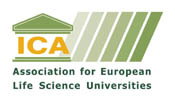Possibility of publishing the papers form the 10th CASEE conference
The journal “Die Bodenkultur: Journal of Land Management, Food and Environment” has kindly offered the partnership to CASEE:
Publishing Partnership of
“Die Bodenkultur: Journal of Land Management, Food and Environment” and “CASEE - The ICA Regional Network for Central and South Eastern Europe”
for publishing Invited Papers based on presentations given at the 10th CASEE Conference in 2019 at the University of Sarajevo from 12 to 15 June 2019
“Die Bodenkultur: Journal of Land Management, Food and Environment” is an interdisciplinary forum dedicated to all aspects of research in the rural areas. The aim of the journal is to provide an international outlet for new results in all disciplines of land management, food, environment and related subjects.
The CASEE Board will invite authors of selected presentations from the CASEE conference to submit a manuscript to the journal “Die Bodenkultur”. Papers will be marked as “Invited papers” with a reference to the CASEE Network and the 10th CASEE conference in Sarajevo on their title page.
Manuscripts must be full research papers and have to be prepared according to the standards of the journal (Instructions for authors can be found at the journal homepage: https://content.sciendo.com/view/journals/boku/boku-overview.xml). Manuscripts shall be submitted until 15 September 2019.
Papers can be written in English or in German. Title, abstract, keywords and tables and graphs captions have to be presented in both languages.
Assistance during the whole submission and revision process will be provided by the journals Managing Editor Reinhard Neugschwandtner (This email address is being protected from spambots. You need JavaScript enabled to view it.).
There are also other journals where the participants in 10th CASEE conference are encouraged to submit their papers after their presentation at CAEEE conference. The review of the submitted papers is not in hands of the conference organizers or CASEE board but depends on the rules of the journals as indicated in the case of Die Bodenkultur. However, the participation in the conference increases the chances for the positive review process because the ideas are discussed before the submission.
In the past, the authors of the previous conferences addressed the journals like:
Agronomy: Scientific Papers. Series A. Agronomy
(http://agronomyjournal.usamv.ro),
Horticulture: Scientific Papers. Series B. Horticulture
(http://horticulturejournal.usamv.ro),
Animal Science: Scientific Papers. Series D. Animal Science
(http://animalsciencejournal.usamv.ro).
Veterinary Medicine: Scientific works. Series C. Veterinary Medicine
(http://veterinarymedicinejournal.usamv.ro),
Land Reclamation, Earth Observation&Surveying, Environmental Engineering: Scientific Papers. Series E. Land Reclamation, Earth Observation & Surveying, Environmental Engineering
(http://landreclamationjournal.usamv.ro),
Biotechnology: Scientific Bulletin "Biotechnology", Series F. Biotechnology
(http://biotechnologyjournal.usamv.ro),
Management and Economics in Rural Areas: Scientific Papers Series G. Management, Economic Engineering in Agriculture and Rural Development,
(http://managementjournal.usamv.ro),
Die Bodenkultur
(http://www.boku.ac.at/en/fos/themen/die-bodenkultur/die-zeitschrift/)
Scientia Agriculturae Bohemica
(https://sab.czu.cz/en/)
Agricultural Economics – Zemedelska ekonomika
https://www.agriculturejournals.cz/web/agricecon/
Czech Journal of Food Sciences
(https://www.agriculturejournals.cz/web/cjfs/)
Czech Journal of Animal Sciences
(https://www.agriculturejournals.cz/web/cjfs/)
Plant Protection Sciences
(https://www.agriculturejournals.cz/web/pps/)
Plant, Soil and Environment
(https://www.agriculturejournals.cz/web/pse/)






